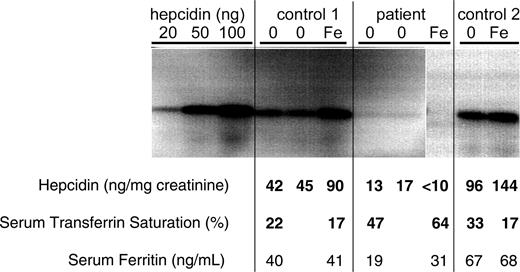Mutations of hepcidin are a rare cause of juvenile hemochromatosis (JH). We report a homozygous -25G>A mutation in the hepcidin 5′ untranslated region (UTR) that generates a new start codon with a consequent frameshift. In this patient with a rare coincidental association of JH, Turner syndrome, and absolute lymphopenia, the absence of normal hepcidin synthesis was expected. Surprisingly, the patient had detectable hepcidin, suggesting that the start of translation was maintained at the original ATG with some normal protein production. However, hepcidin was not appropriately induced by an iron challenge test, supporting role of hepcidin on the clinical expression of iron overload in this case.
The hepatic peptide hepcidin is a key regulator of iron balance.1 Mutations of hepcidin are a rare cause of juvenile hemochromatosis (JH),2,3 and include nonsense, frameshift,2 and missense mutations C70R and C78T affecting conserved cysteines.3-5
Recently a -25G>Amutation in the HAMP 5′UTR was described in 2 Portuguese siblings with iron overload and absence of urinary hepcidin.6 Here, the same mutation was found in a different Portuguese family where the proband shows coincidental association of JH, Turner syndrome, and absolute lymphopenia.7 Although no comparative haplotype analysis was performed, geographic and historical tracking does not indicate any relationship with the previously described family. In the proband, no mutations in the coding regions of HAMP and hemojuvelin genes were found by sequencing.3,8 However, in the 5′UTR region of HAMP, a G>A point mutation was identified at position -25 from the canonical ATG. This was confirmed by WAVE (Transgenomic, Omaha, NE) denaturing high-performance liquid chromatography (DHPLC; heteroduplexes were formed by heat denaturation at 94°C for 3 minutes and cooling to 25°C for 45 minutes; the mixture was analyzed at a melting temperature of 64.1°C, with a linear acetonitrile gradient: Start: 44.3% Buffer A, 55.7% Buffer B; Stop: 35.3% Buffer A, 64.7% Buffer B). In a family study performed with written informed consent, both parents and one brother were heterozygous for the mutation. Elevated serum ferritin levels in these subjects were likely due to the additional effect of regular high alcohol intake.
The G>A substitution changes GTG to ATG and creates a new start site for translation. Since this mutation introduces an earlier initiation codon with a shifted reading frame, it would be expected to encode a different peptide. Surprisingly, urinary hepcidin, analyzed in first morning voided samples,9 was detected in the proband at a concentration of 12 ng/mg creatinine with a serum ferritin concentration of 19 ng/mL at the time of evaluation. The result was confirmed by Western blot analysis. The production of hepcidin could be explained by the maintenance of the start of translation at the original ATG, a phenomenon also observed with other genes.10 In this case, urinary hepcidin was evaluated when iron depletion had been already achieved by phlebotomy treatment. To explain the initial severe phenotype of the patient, we hypothesized that hepcidin was not appropriately induced by iron and performed an iron challenge test with urinary hepcidin determination 24 hours after the ingestion of 80 mg iron as ferrous sulfate.9 No increase in urinary hepcidin was observed in the patient, in contrast with a 2- to 3-fold increase observed in 2 control subjects (Figure 1). Of interest, a reduction in serum transferrin saturation was observed in controls 24 hours after the iron challenge (Figure 1). In contrast, the transferrin saturation in the patient increased with the iron challenge. We interpret the late reduction of transferrin saturation in the controls as a delayed effect of hepcidin increase. The lack of this response in the patient supports the notion that defective hepcidin regulation played a role in her iron overload.
Urinary hepcidin levels in 2 controls and the proband, before and after ingestion of 80 mg iron as ferrous sulfate. Synthetic hepcidin standards (20, 50, and 100 ng) and urinary extracts equivalent to 0.5 mg creatinine were analyzed by sodium dodecyl sulfate-polyacrylamide gel electrophoresis (SDS-PAGE) and Western blotting with rabbit anti-human hepcidin antibody. 0 = urine collected before iron ingestion; Fe = urine collected 24 hours after iron ingestion. Measures of urinary hepcidin, serum transferrin saturation, and serum ferritin are given for each subject at the indicated test times.
Urinary hepcidin levels in 2 controls and the proband, before and after ingestion of 80 mg iron as ferrous sulfate. Synthetic hepcidin standards (20, 50, and 100 ng) and urinary extracts equivalent to 0.5 mg creatinine were analyzed by sodium dodecyl sulfate-polyacrylamide gel electrophoresis (SDS-PAGE) and Western blotting with rabbit anti-human hepcidin antibody. 0 = urine collected before iron ingestion; Fe = urine collected 24 hours after iron ingestion. Measures of urinary hepcidin, serum transferrin saturation, and serum ferritin are given for each subject at the indicated test times.
Partially supported by Telethon, Rome and Ministero dell'Istruzione, dell'Università e della Ricerca, Fondo per gli Investimenti della Ricerca di Base (MIUR FIRB) to C.C.; and the Gulbenkian Foundation and the Portuguese Foundation for Science and Technology (FCT).
The authors wish to acknowledge nurse Graça Melo for her work on the recruitment, organization, and collection of samples for the family study.


This feature is available to Subscribers Only
Sign In or Create an Account Close Modal